[/caption]
Will aircraft of the future look something like this? Project NACRE (New Aircraft Concepts Research) has this wide-body aircraft in mind for future flyers, designed for long-haul flights and able to accommodate up to 750 passengers. Measuring 65 meters long, 19 meters high with a wingspan of nearly 100 meters, the maximum take-off weight of the simulated flying wing is roughly 700 tons. The German Aerospace Center (Deutsches Zentrum für Luft- und Raumfahrt; DLR) has been performing flight tests to simulate and study the flight characteristics of large ‘flying wing’ configurations to prepare for future aircraft designs, using special airplane called ATTAS (Advanced Technologies Testing Aircraft System) research aircraft that has special software and hardware that can mimic the flight characteristics and performance of an entirely different aircraft.
What are some other future airplane concepts?
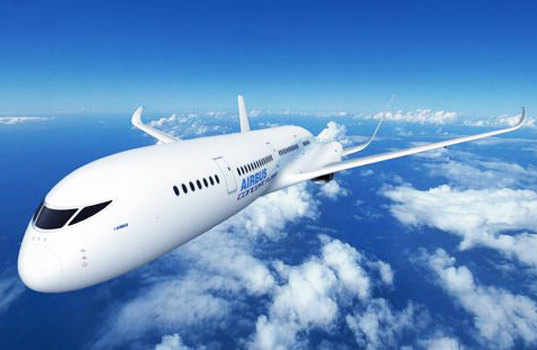
Airbus has this concept in mind – called a fantasy plane – that could be more fuel efficient because of its long, curled wings, a U-shaped tail, and a lightweight body. This could be the way planes look in 2030, Airbus says, and will have advanced interior systems, and be much quieter than current aircraft.
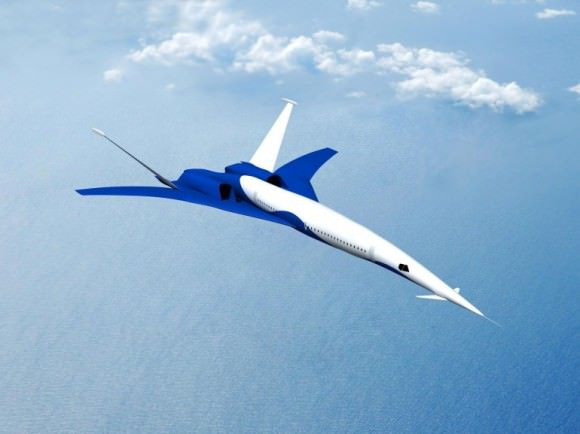
This supersonic aircraft concept by Boeing is nicknamed Icon II has V-tails and upper surface engines, and can carry 120 passengers in a two-class, single-aisle interior, and can cruise at Mach 1.6 to Mach 1.8 with a range of about 5,000 nautical miles.
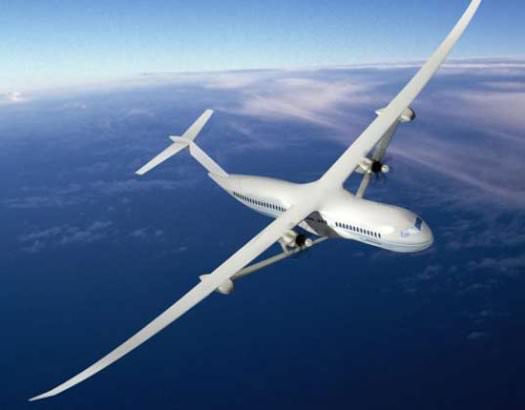
Another concept from Boeing is the SUGAR Volt – which includes an electric battery gas turbine hybrid propulsion system – can reduce fuel burn by more than 70 percent and total energy use by 55 percent. This fuel burn reduction and the “greening” of the electrical power grid can greatly reduce emissions of life cycle carbon dioxide and nitrous oxide. Hybrid electric propulsion also has the potential to shorten takeoff distance and reduce noise.
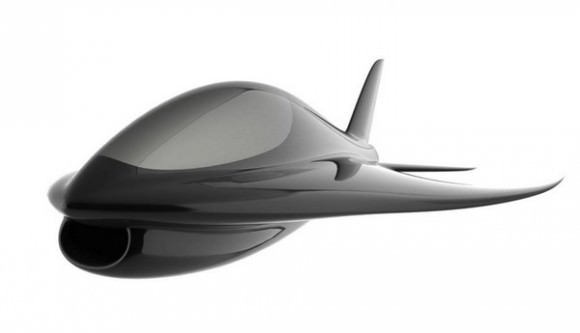
This one is called the SmartFish, and utilizes a “lifting body” design, which means that the entire aircraft works to provide lift, rather than just the wings. The concept for this plane is a slender shape and composite material construction, which means less drag, and thus less thrust required for flight. The wing and fuselage form one integrated, futuristic-looking design. This plane can fly without slats, flaps, or spoilers, meaning increased fuel efficiency. See more on the SmartFish website.
Those are just a few concepts being tested and designed for the future of flight. You can read more about NASA’s work on the future of aeronautics here.

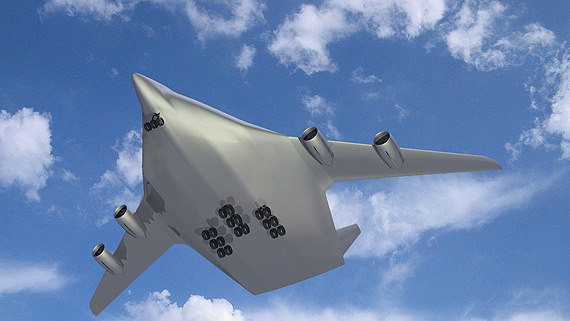
Hey where is the Oblique Wing concept?
Maybe under a different moniker, define an oblique wing for us?
http://en.wikipedia.org/wiki/Oblique_wing
was that so hard?
Clearly fuel efficiency is going to play a larger role in the future. I doubt supersonic flight will ever by commercially viable.
LC
Yeah sonic booms kind of limit where and when such planes can be flown. Trans pacific and atlantic flights might employ them.
I wouldn’t call the ‘Flying Wing’ a particularly new concept. Didn’t the American airforce actually develop one in th early 50’s? Can’t remember the designation but I think it was a ‘B’- something. The Boeing Icon type looks just like the ‘Fireflash’ model aeroplane that appeared in the ‘Thunderbirds’ series here in Britain in the 1960’s. I still think HOTOL is the best design I’ve seen.
My father used to see one flying in England in what must have been the late 40s or early 50s and was most impressed by the strangeness of it but he’s no longer around to say what it looked like. I don’t know whether any of the Northrop designs ever made it to England or whether it was something else.
Ah yes. The Flying Wing was the Northrop YB-49. Looks very futuristic even now.
Looking on the net there are actually bloody hundreds of them!
I thin all of these designs are going the wrong direction. The future of aeronautics will be in craft that are combinations of airships and aircraft (described in this article as ‘hybrids’). As the biggest expense in flying aircraft is the take off, it makes perfect sense to decrease drag by using helium to lighten the weight of the craft. By changing the airship design to be more streamline and adding smaller efficient jet engines, transport in the air can remain affordable against the dramatic rise in costs expected in the near future.
Why not have a craft that can float or be assisted to get into the upper atmosphere, then use its thrust to move it to where it is going, and land (or glide) like a normal aircraft.
Frankly, I also think your are quite off track with aircraft speed. I think future aircraft will be slower in the future based on the cost of fuels and energy efficiency; and of course minimising the damage to the environment. It is basically a trade off to keep the rise of prices in check and the increasing number of people expecting to fly.
It is also funny that the designs shown here are mostly from the 1970s and are not modern at all. “Dreamliners”, as shown here, are a baked-up manufactured idea based on unlimited amounts of earth-based resources dating back to before the WWII. Future changes in modern aircraft design are not based solely on technology but limiting of available resources.
Correction: I think all of these designs are going the wrong direction.
I’m skeptical of that.
Helium has a lifting force of one gram per litre. That’s a cubic metre of helium for each kilogram to be lifted – a large volume for not very much gain. That gives you a large cross-section (thanks to the large volume) to propel through the air – which will require more fuel that otherwise, especially if you’ve got winds to go up against.
I don’t know how fuel efficient light-than-air craft generally are, but I very much doubt they will ever play a big part in air travel in the future.
Good points Run. The problem is certainly the weight ratio to the mass of the craft and the helium required to lift it. I think the technology for “helium aircraft” that is discussed is to make the airplane buoyancy lighter by 30% to 40%, reducing the fuel consumption. I have heard of Dual-Aerostatic-Lift systems. These include a novel use of vacuum-lift (like the Smartfish imaged here) and a lifting gas. On the other end of the scale are hybrid airships like the Aeroscraft; best used for cargo transport than commercial flights with passengers. (http://en.wikipedia.org/wiki/Aeroscraft)
However, I thought the limitation was mostly the cost of helium. (You could use hydrogen, but the technology is make it safe would also be prohibitive in cost.)
In the end it will be the cost of the aviation fuel or its scarcity that will rise to a tipping point where the alternatives become far more cost effective. That time is not too far off.
Thanks for making me think more about this!
It’s not that airships or hybrid airplane/airships are unworkable, it’s just that there are a lot of minor issues that would make largescale use of such technology unlikely, limiting it to a few niche areas (IE, a hybrid would necessarilyi travel at a fraction of the speed of an airplane. I was just on a 12 hour flight. Even with “first class” setting for everyone, would I want to turn that into a 72 hour flight? No. Never. Not in a million years).
Anyway, ignoring all the little technical problems that would need to be worked through (I’m sure someone will figure them out if it’s worthwhile to do so:)), I’d say that you’re correct that the ultimate limiting factor is the price of helium. But you don’t go quite far enough.
The price of helium right now, and for the past few decades, has been set by the US government. That’s because during the early part of the cold war the US federal government built up an enormous strategic reserve of helium, figuring that they’d eventually find a good way to use it all (it is required for most rocket launches, so I think you can see why they did it). Eventually they decided that they didn’t need a strategic reserve of helium, so they began selling it off a bit at a time.
The problem was that the industrial and commercial markets couldn’t absorb the amount of helium that the US wanted to sell off, so they began selling it off for a fraction of a penny on the dollar. This meant that the market could find new uses for helium that previously hadn’t been possible, due to the absurdly low (below cost) selling price.
As an example, right now it costs about 50 cents per birthday party balloon . Estimates are that the *real* cost to produce that helium is about 100 dollars per balloon.
The really bad part of all this? The fact the the US government has been selling helium at below cost completely killed off essentially all helium production worldwide. We’re currently running almost exclusively on the US national reserve… which will run dry inside a few years.
No more helium at 1/200th of it’s actual cost means no airships (and, in the short term, I’d be rather worried about any rocket launching system that uses helium to flush their rockets. There is *no* replacement for helium due to it’s low freezing/condensation point and low density).
I used to work with ultra high vacuum equipment that used liquid helium to cool the pumps. We had a large tank of it that was regularly filled by a truck and we used the stuff like water with no thought of the cost.
I certainly think that Zeppelin-type craft could/should be used for the transport of non-urgent/bulk materials. Just think of the amount of aviation or container ship fuel used to move Nike trainers or replica football shirts around the globe. I mean how urgently do you need the latest Manchester United [fill in the team and sport of your choice] strip?
“I certainly think that Zeppelin-type craft could/should be used for the transport of non-urgent/bulk materials.”
You must have been reading my mind in my reply to Run above.
(As for the Manchester United it made me think of the Munich air crash on 7th February 1958. A sad reminder of the need for safety in these possible new designs, too.)
Perhaps we should go back to sailing ships for that. I heard that the engines of a container ship carrying a load of cars will produce more pollution on the voyage from China or wherever to the UK than all of the cars in their entire lifetime!
I think we should invest in magnetic rail runways to assist in take off. Maybe reduce fuel consumption in takeoffs. Similar to Aircraft carriers.
Or even better, have dedicated Tug crafts that are electric powered parked at airports that connects to the airliner, use it to take off to reasonable altitude, detach and come back land again.
Just an idea…
Joe
The original Boeing BWB design, the 1995 Pop_Sci Cover, McDonnell Douglas Mega Plane, is an almost exact copy of a 1951 BWB design by Texas born, Vincent Burnelli. Check it out. http://www.ontomax.com/newsarchive/2008/march.htm
This “new” design is closer to Burnelli’s favored design, the Lifting Fuselage. See his actual planes here. http://www.burnelli.com/Welcome.html The opening page shows Burnelli’s last design before his death in 1964, a 400/500 passenger, supersonic airliner.
Don’t think this design could go supersonic? How about hypersonic? Compare this design with NASA’s X-43B and X-51 hypersonics. (X-43A flew at Mach 9.6, X-51 Mach 5+/-). Google, Images of these designs. All are Lifting Fuselage designs with flat or slab sides, strikingly similar to Burnelli’s supersonic plane. (And yes, composites are now proven to hold an atmosphere with this design.)
Still don’t think Burnelli’s work was right on? Check out what a Langley, Sr. Aeronautical Engineer had to say. http://www.meridian-int-res.com/Aeronautics/Burnelli_AIAA.pdf Then read research in layman’s terms, that explains the superiority of the Lifting Fuselage design. http://www.meridian-int-res.com/Aeronautics/Burnelli.htm
I’m workin’ on it. http://www.aviationpeopletalk.net/ (Halfway down the page)
ccccccccccooooooooooooooooooooooolllllllllllllllllllllllll